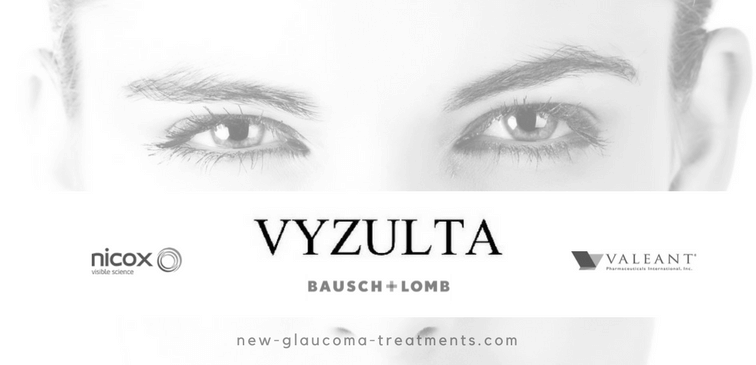
On November 2, 2017, the FDA approved VYZULTA™ (latanoprostene bunod 0.024%) for the treatment of glaucoma. This newly available medication treats glaucoma in two distinct ways.
One of these methods of protecting the optic nerve has already been available to those with glaucoma who use prostaglandin analogs such as Xalatan® (latanoprost), Lumigan® (bimatoprost), Travatan-Z® (travoprost), and Zioptan™ (tafluprost). These medications work to lower intraocular pressure (IOP) by opening the uveoscleral pathway through which aqueous fluid can leave the eye.
FDA approval: November 2nd, 2017
Brand name: Vyzulta
Generic name: latanoprostene bunod
Dosage form: Ophthalmic Solution
Previous name: Vesneo
Company: Valeant Pharmaceuticals International, Inc.
Treatment for: Glaucoma, Open Angle, Intraocular Hypertension
A Prostaglandin Analog “Plus”
VYZULTA™ (latanoprostene bunod 0.024%), however, is not just a prostaglandin analog. In addition to treating glaucoma by lowering the IOP, it also releases a molecule of nitric oxide. Why is this important? Studies suggest that there is less nitric oxide activity in patient with glaucoma than in those without.
Nitric oxide is a free-radical that can induce oxidative damage and result in death of the retinal ganglion cells. Why, then, would a drug company want to create a glaucoma medication that “donates” nitric oxide? Wouldn’t it make sense to instead create a nitric oxide “stealing” or “scavenging” molecule?
As with most things in physiology, nitric oxide is neither “good” nor “bad” for the optic nerve. Rather, like red wine, its function depends upon when, where, and how much of it is available. Indeed, it was even named “Molecule of the Year” in 19921and a Nobel Prize was awarded in 1998 for research about nitric oxide.
Nitric oxide is used by cells to “signal” or communicate with each other.2 Additionally, it has a powerful dilating effect on blood vessels. Inadequate blood supply to the optic nerve may play a role in glaucoma. Thus, it makes sense that molecules with the ability to modify blood supply could have a beneficial effect in the treatment of glaucoma.
There is, however, an additional mechanism by which nitric oxide appears to work in the treatment of glaucoma. Evidence suggests that it may increase aqueous outflow through the trabecular meshwork and Schlemm’s canal. As such, this one medication takes advantage of both known outflow pathways used by currently available FDA approved glaucoma drops.
“Well, how much better is it than latanoprost?”
Initial Glaucoma Study Results of VYZULTA™ (latanoprostene bunod 0.024%)
Given that VYZULTA™ (latanoprostene bunod 0.024%) is essentially “latanoprost plus” it makes sense to ask the question, “Well, how much better is it than latanoprost?”. The answer, unfortunately, may disappoint. According to the VOYAGER study,3 VYZULTA™ averaged just over 1mmHg of added IOP reduction compared to latanoprost. Of interest, however, is that almost 70% of those taking VYZULTA™ achieved an average IOP of 18mmHg or less whereas less than 50% of those taking latanoprost achieved the same average IOP.
Side effects are essentially the same as those associated with other prostaglandin analogs: lash growth, iris color change, as well as darkening and tightening of the eyelids.
Summary
The prostaglandin analog class of glaucoma medications is one of the most effective at controlling IOP. This class of medication, however, has only one method of action: improving uveoscleral outflow. VYZULTA™ (latanoprostene bunod 0.024%), on the other hand, appears to use all outflow pathways acting as a prostaglandin analog “plus”.
Could there even be a nitric oxide dependent neuroprotective effect of this medication? It’s not known, but I am hopeful future clinical studies comparing the impact on visual field progression with use of latanoprost versus latanoprostene bunod will answer that question.
IMPORTANT SAFETY INFORMATION
- Increased pigmentation of the iris, periorbital tissue (eyelid), and eyelashes can occur. Iris pigmentation is likely to be permanent
- Gradual changes to eyelashes, including increased length, increased thickness, and number of eyelashes, may occur. These changes are usually reversible upon treatment discontinuation
- Most common ocular adverse reactions with incidence ≥2% are conjunctival hyperemia (6%), eye irritation (4%), eye pain (3%), and instillation site pain (2%)
Source: ir.valeant.com Please see full prescribing information at www.bausch.com/vyzulta.
Related Articles:
References:
- Culotta, Elizabeth and Koshland, Daniel E. Jr (1992). “NO news is good news”. Science 258 (5090): 1862–1864.
- Stryer, Lubert (1995). Biochemistry, 4th Edition. W.H. Freeman and Company. p. 732.
- , , , et al A randomised, controlled comparison of latanoprostene bunod and latanoprost 0.005% in the treatment of ocular hypertension and open angle glaucoma: the VOYAGER study British Journal of Ophthalmology
Sick of High IOPs? Tired of taking Drops?

David Richardson, MD
Medical Director, San Marino Eye
David Richardson, M.D. is recognized as one of the top cataract and glaucoma surgeons in the US and is among an elite group of glaucoma surgeons in the country performing the highly specialized canaloplasty procedure. Morever, Dr. Richardson is one of only a few surgeons in the greater Los Angeles area that performs MicroPulse P3™ "Cyclophotocoagulation" (MP3) glaucoma laser surgery. Dr. Richardson graduated Magna Cum Laude from the University of Southern California and earned his Medical Degree from Harvard Medical School. He completed his ophthalmology residency at the LAC+USC Medical Center/ Doheny Eye Institute. Dr. Richardson is also an Ambassador of Glaucoma Research Foundation.


